
The Parrott rifle was a type of muzzle-loading rifled artillery weapon used extensively in the American Civil War. [1]

The Parrott rifle was a type of muzzle-loading rifled artillery weapon used extensively in the American Civil War. [1]
The gun was invented by Captain Robert Parker Parrott, [1] a West Point graduate. He was an American soldier and inventor of military ordnance. He resigned from the service in 1836 and became the superintendent of the West Point Foundry in Cold Spring, New York. He created the first Parrott rifle (and corresponding projectile) in 1860 and patented it in 1861. [2] Daniel Treadwell, who developed a method for making built-up guns in the early 1840s, tried to claim that his patent infringed on an earlier one, but in 1866 S.D.N.Y. court dismissed it, deciding that Treadwell's claim was invalidated by a 1843 British patent to John Frith. [3]
Parrotts were manufactured with a combination of cast and wrought iron. The cast iron made for an accurate gun, but was brittle enough to suffer fractures. Hence, a large wrought iron reinforcing band was overlaid on the breech to give it additional strength. There were earlier cannons designed this way,[ clarification needed ] but the method of securing this band was the innovation that allowed the Parrott to overcome the deficiencies of these earlier models.[ citation needed ] It was applied to the gun red-hot and then the gun was turned while pouring water down the muzzle, allowing the band to attach uniformly. [4] By the end of the Civil War, both sides were using this type of gun extensively.
Parrott rifles were manufactured in different sizes, from the 10-pounder Parrott rifle up to the rare 300-pounder. [5] In the field, the 10- and 20-pounders were used by both armies. The 20-pounder Parrott rifle was the largest field gun used during the war, with the barrel alone weighing over 1,800 pounds (820 kg). The smaller size was much more prevalent; it came in two bore sizes: 2.9 inches (74 mm) and 3.0 inches (76 mm). Confederate forces used both bore sizes during the war, which added to the complication of supplying the appropriate ammunition to its batteries. Until 1864, Union batteries used only the 2.9 inches (74 mm). The M1863, with a 3.0 inches (76 mm) bore, had firing characteristics similar to the earlier model; it can be recognized by its straight barrel, without muzzle-swell. Its range was up to 2,000 yards (1,800 m) with a trained crew. [6]
On June 23-24, 1862, President Abraham Lincoln made an unannounced visit to West Point, where he consulted with retired Gen. Winfield Scott regarding the handling of the Civil War and the staffing of the War Department. Following this meeting, President Lincoln visited the West Point Foundry at which the 100- and 200-pounder Parrott cannons were successfully demonstrated in live firing. [7]
Naval versions of the 20-, 30-, 60-, and 100-pounder Parrotts were also used by the Union navy. [8] The 100-pound naval Parrott could achieve a range of 6,900 yards (6,300 meters) at an elevation of 25 degrees, or fire an 80 lb (36 kg) shell 7,810 yards (7,140 m) at 30 degrees elevation. [8]
Although accurate, as well as being cheaper and easier to make than most rifled artillery guns, the Parrott had a poor reputation for safety and they were shunned by many artillerists. [9] At the end of 1862, Henry J. Hunt attempted to get the Parrott eliminated from the Army of the Potomac's inventory, preferring the 3-inch ordnance rifle. When the Parrott gun burst in battle, gunners would chip out the jagged parts and continue firing. [10] In 1889, The New York Times called on the Ordnance Bureau of the War Department to discontinue use of the Parrott gun altogether, following a series of mishaps at the West Point training grounds. [9]
Several hundred Parrott gun tubes remain today, many adorning battlefield parks, county courthouses, and museums. The gun tubes made by Parrott's foundry are identifiable by the letters WPF (West Point Foundry), along with a date stamp between 1860 and 1889, found on the front face of the gun tube. The first production Parrott gun tube (serial number 1) still exists, and is preserved on a reproduction gun carriage in the center square of Hanover, Pennsylvania, as part of a display commemorating the Battle of Hanover. A list of many of the surviving tubes can be found at the National Register of Surviving Civil War Artillery.
The larger sizes of Parrott rifles (100-pounder and up) were deployed in coast defense from 1863 to 1900, when they were replaced by Endicott period forts and weapons. Along with Rodman guns, some were deployed shortly after the outbreak of the Spanish–American War in 1898 as a stopgap; it was feared the Spanish fleet would bombard the US East Coast. [11]
By summer 1863, Union forces became frustrated by the heavily fortified Confederate position at Fort Sumter, and brought to bear the 10-inch (250 mm) Parrott, along with several smaller cannons. In all, two 80-pounder Whitworths, nine 100-pounder Parrotts, six 200-pounder Parrotts, and a 300-pounder Parrott [12] were deployed. It was widely believed in the north that a massive 10-in Parrott would finally break the previously impenetrable walls of the fort, which had become the symbol of stalwart steadfastness for the Confederacy. [13]
The Washington Republican described the technical accomplishments of the 10-inch (25 cm) Parrott:
The breaching power of the 10-inch 300-pounder Parrott rifled gun, now about to be used against the brick walls of Fort Sumter, will best be understood by comparing it with the ordinary 24-pounder siege gun, which was the largest gun used for breaching during the Italian War. [13]
The 3.75-inch-bore (9.5 cm)24 lb (11 kg) shot, with a muzzle velocity of 1,625 ft/s (495 m/s), strikes a target at 3,500 yd (3,200 m) with a velocity of about 300 ft/s (91 m/s) (this is almost beyond the range of the weapon). In contrast, the 10-inch-bore (250 mm)300 lb (140 kg) shot, with a muzzle velocity of 1,111 ft/s (339 m/s), strikes the target at the same range still moving at 700 ft/s (210 m/s), due to its much higher mass-to-drag ratio. The resulting huge difference in impact energy, 33,000 ft⋅lbf (45,000 J) for the 24 lb (11 kg) shell, and over 2,000,000 ft⋅lbf (2,700,000 J) for the 300 lb (140 kg) shell, means the penetrating energy of the larger shell is 20 times that of the smaller.
In terms of the ability to punch holes in fortifications, at that long range the light 24 lb (11 kg) shell would be expected to only breach a 6-inch-thick (150 mm) brick wall. In contrast, the greater mass and retained velocity of the 300 lb (140 kg) shell would enable it to penetrate 6 to 7 ft (180 to 210 cm) of brick (given the quality of the material back then). The Union soldiers knew Fort Sumter's brick walls averaged about 5 feet (150 cm) thick, and thus recognized the potential for such a cannon to help them succeed in taking back their Fort.

A famous large 8-inch (200 mm) Parrott cannon, called the Swamp Angel, was used by federal Brigadier General Quincy Adams Gillmore to bombard Charleston, South Carolina. It was manned by the 11th Maine Volunteer Infantry Regiment. [14]
On August 21, 1863 Gillmore sent Confederate general P. G. T. Beauregard an ultimatum to abandon heavily fortified positions at Morris Island or the city of Charleston would be shelled. When the positions were not evacuated within a few hours, Gillmore ordered the Parrott rifle to fire on the city. Between August 22 and August 23, the Swamp Angel fired on the city 36 times (the gun burst on the 36th round), using many incendiary shells which caused little damage and few casualties. [14] The battle was made more famous by Herman Melville's poem "The Swamp Angel". [15]
After the war, a damaged Parrott rifle said to be the Swamp Angel was moved to Trenton, New Jersey, where it rests as a memorial today at Cadwalader Park. [16] [17]



| Model | Length | Weight | Munition | Charge size | Maximum range at elevation | Flight time | Crew size |
|---|---|---|---|---|---|---|---|
| 2.9-in (10-lb) Army Parrott | 73 in (190 cm) | 890 lb (400 kg) | 10 lb (4.5 kg) shell | 1 lb (0.45 kg) | 5,000 yd (4,600 m) at 20 degrees | 21 secs | 8 |
| 3.0-in (10-lb) Army Parrott | 74 in (190 cm) | 890 lb (400 kg) | 10 lb (4.5 kg) shell | 1 lb (0.45 kg) | 1,830 yd (1,670 m) at 5 degrees | 7 secs | 8 |
| 3.67-in (20-lb) Army Parrott | 79 in (200 cm) | 1,795 lb (814 kg) | 19 lb (8.6 kg) shell | 2 lb (0.91 kg) | 4,400 yd (4,000 m) at 15 degrees | 17 secs | 8 |
| 3.67-in (20-lb) Naval Parrott | 81 in (210 cm) | 1,795 lb (814 kg) | 19 lb (8.6 kg) shell | 2 lb (0.91 kg) | 4,400 yd (4,000 m) at 15 degrees | 17 secs | 8 |
| 4.2-in (30-lb) Army Parrott | 126 in (320 cm) | 4,200 lb (1,900 kg) | 29 lb (13 kg) shell | 3.25 lb (1.47 kg) | 6,700 yd (6,100 m) at 25 degrees | 27 secs | 9 |
| 4.2-in (30-lb) Naval Parrott | 102 in (260 cm) | 3,550 lb (1,610 kg) | 29 lb (13 kg) shell | 3.25 lb (1.47 kg) | 6,700 yd (6,100 m) at 25 degrees | 27 secs | 9 |
| 5.3-in (60-lb) Naval Parrott | 111 in (280 cm) | 5,430 lb (2,460 kg) | 50 lb (23 kg) or 60 lb (27 kg) shell | 6 lb (2.7 kg) | 7,400 yd (6,800 m) at 30 degrees | 30 secs | 14 |
| 5.3-in (60-lb) Naval Parrott (breechload) | 111 in (280 cm) | 5,242 lb (2,378 kg) | 50-lb or 60 lb (27 kg) shell | 6 lb (2.7 kg) | 7,400 yd (6,800 m) at 30 degrees | 30 secs | 14 |
| 6.4-in (100-lb) Naval Parrott | 138 in (350 cm) | 9,727 lb (4,412 kg) | 80 lb (36 kg) or 100 lb (45 kg) shell | 10 lb (4.5 kg) | 7,810 yd (7,140 m) at 30 degrees (80-lb) | 32 secs | 17 |
| 6.4-in (100-lb) Naval Parrott (breechload) | 138 in (350 cm) | 10,266 lb (4,657 kg) | 80 lb (36 kg) or 100 lb (45 kg) shell | 10 lb (4.5 kg) | 7,810 yd (7,140 m) at 30 degrees (80-lb) | 32 secs | 17 |
| 8-in (150-lb) Naval Parrott | 146 in (370 cm) | 16,500 lb (7,500 kg) | 150 lb (68 kg) shell | 16 lb (7.3 kg) | 8,000 yd (7,300 m) at 35 degrees | 180 | ? |
| 8-in (200-lb) Army Parrott | 146 in (370 cm) | 16,500 lb (7,500 kg) | 200 lb (91 kg) shell | 16 lb (7.3 kg) | 8,000 yd (7,300 m) at 35 degrees | ? | ? |
| 10-in (300-lb) Army Parrott | 156 in (400 cm) | 26,900 lb (12,200 kg) | 300 lb (140 kg) shell | 26 lb (12 kg) | 9,000 yd (8,200 m) at 30 degrees | 202.5 secs* | ? |
(*) This time is an educated guess, the time is unknown. Flight times appear to be extremely inaccurate. Example: 10-in (300-lb) projectile would have to average only 133 ft/s (41 m/s) to be in flight for 202 seconds to cover 9,000 yd (8,200 m). A more accurate estimate will be in the range of 30 seconds.
Contemporary rifled artillery
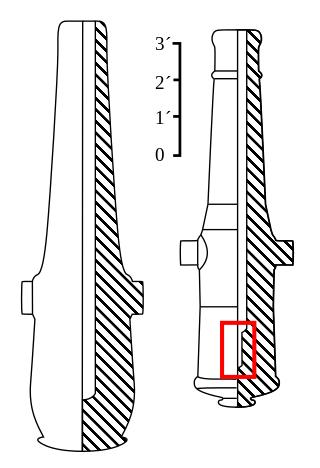
The Rodman gun is any of a series of American Civil War–era columbiads designed by Union artilleryman Thomas Jackson Rodman (1815–1871). The guns were designed to fire both shot and shell. These heavy guns were intended to be mounted in seacoast fortifications. They were built in 8-inch, 10-inch, 13-inch, 15-inch, and 20-inch bore. Other than size, the guns were all nearly identical in design, with a curving bottle shape, large flat cascabels with ratchets or sockets for the elevating mechanism. Rodman guns were true guns that did not have a howitzer-like powder chamber, as did many earlier columbiads. Rodman guns differed from all previous artillery because they were hollow cast, a new technology that Rodman developed that resulted in cast-iron guns that were much stronger than their predecessors.
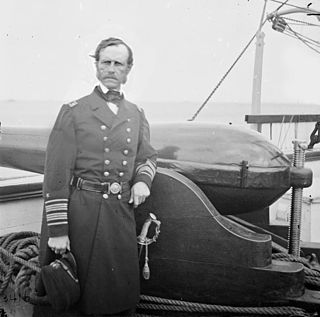
Dahlgren guns were muzzle-loading naval gun designed by Rear Admiral John A. Dahlgren USN, mostly used in the period of the American Civil War. Dahlgren's design philosophy evolved from an accidental explosion in 1849 of a 32 lb (14.5 kg) gun being tested for accuracy, killing a gunner. He believed a safer, more powerful naval cannon could be designed using more scientific design criteria. Dahlgren guns were designed with a smooth curved shape, equalizing strain and concentrating more weight of metal in the gun breech where the greatest pressure of expanding propellant gases needed to be met to keep the gun from bursting. Because of their rounded contours, Dahlgren guns were nicknamed "soda bottles", a shape which became their most identifiable characteristic.
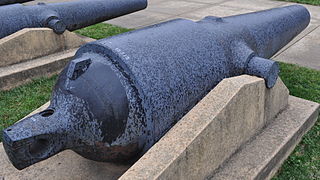
The Brooke rifle was a type of rifled, muzzle-loading naval and coast defense gun designed by John Mercer Brooke, an officer in the Confederate States Navy. They were produced by plants in Richmond, Virginia, and Selma, Alabama, between 1861 and 1865 during the American Civil War. They served afloat on Confederate ships and ashore in coast defense batteries operated by the Confederate States Army.

Field artillery in the American Civil War refers to the artillery weapons, equipment, and practices used by the Artillery branch to support the infantry and cavalry forces in the field. It does not include siege artillery, use of artillery in fixed fortifications, or coastal or naval artillery. Nor does it include smaller, specialized artillery classified as small arms.

The columbiad was a large-caliber, smoothbore, muzzle-loading cannon able to fire heavy projectiles at both high and low trajectories. This feature enabled the columbiad to fire solid shot or shell to long ranges, making it an excellent seacoast defense weapon for its day. Invented by Colonel George Bomford, United States Army, in 1811, columbiads were used in United States seacoast defense from the War of 1812 until the early years of the 20th century. Very few columbiads were used outside of the U.S. and Confederate Armies; nevertheless, the columbiad is considered by some as the inspiration for the later shell-only cannons developed by Frenchman Henri-Joseph Paixhans some 30 years later.

The siege of Fort Pulaski concluded with the Battle of Fort Pulaski fought April 10–11, 1862, during the American Civil War. Union forces on Tybee Island and naval operations conducted a 112-day siege, then captured the Confederate-held Fort Pulaski after a 30-hour bombardment. The siege and battle are important for innovative use of rifled guns which made existing coastal defenses obsolete. The Union initiated large-scale amphibious operations under fire.

The Second Battle of Charleston Harbor, also known as the Siege of Charleston Harbor, the Siege of Fort Wagner, or the Battle of Morris Island, took place during the American Civil War in the late summer of 1863 between a combined U.S. Army/Navy force and the Confederate defenses of Charleston, South Carolina.

Siege artillery is heavy artillery primarily used in military attacks on fortified positions. At the time of the American Civil War, the U.S. Army classified its artillery into three types, depending on the gun's weight and intended use. Field artillery were light pieces that often traveled with the armies. Siege and garrison artillery were heavy pieces that could be used either in attacking or defending fortified places. Seacoast artillery were the heaviest pieces and were intended to be used in permanent fortifications along the seaboard. They were primarily designed to fire on attacking warships. The distinctions are somewhat arbitrary, as field, siege and garrison, and seacoast artillery were all used in various attacks and defenses of fortifications. This article will focus on the use of heavy artillery in the attack of fortified places during the American Civil War.
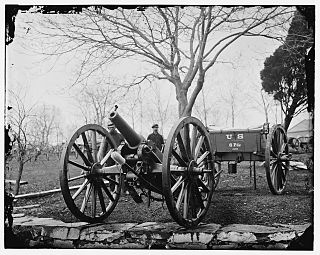
The Wiard rifle refers to several weapons invented by Norman Wiard, most commonly a semi-steel light artillery piece in six-pounder and twelve-pounder calibers. About 60 were manufactured between 1861 and 1862 during the American Civil War, at O'Donnell's Foundry, New York City: "although apparently excellent weapons, [they] do not seem to have been very popular". Wiard also designed a rifled steel version of the Dahlgren boat howitzer, among other gun types. Further, Wiard unsuccessfully attempted to develop a 15 in (381 mm) rifled gun for the US Navy and proposed a 20 in (510 mm) gun. In 1881 he unsuccessfully proposed various "combined rifle and smoothbore" weapon conversions of Rodman guns and Parrott rifles.

James rifle is a generic term to describe any artillery gun rifled to the James pattern for use in the American Civil War, as used in some period documentation. Charles T. James developed a rifled projectile and rifling system. Modern authorities such as Warren Ripley and James Hazlett have suggested that the term "James rifle" only properly applies to 3.8 in (97 mm) bore field artillery pieces rifled to fire James' projectiles. They contend that the term does not apply to smoothbores that were later rifled to take the James projectiles in 3.67 in (93 mm) caliber or other calibers, and that those should instead be referred to as "Rifled 6 pounder", etc. The rifle was created in 1861.
Blakely rifle or Blakely gun is the name of a series of rifled muzzle-loading cannon designed by British army officer Captain Theophilus Alexander Blakely in the 1850s and 1860s. Blakely was a pioneer in the banding and rifling of cannon but the British army declined to use Blakely's design. The guns were mostly sold to Russia and the Confederacy during the American Civil War. Blakely rifles were imported by the Confederacy in larger numbers than other Imported English cannon. The State of Massachusetts bought eight 9 in (23 cm) and four 11 in (28 cm) models.

The 68-pounder cannon was an artillery piece designed and used by the British Armed Forces in the mid-19th century. The cannon was a smoothbore muzzle-loading gun manufactured in several weights, the most common being 95 long cwt (4,800 kg), and fired projectiles of 68 lb (31 kg). Colonel William Dundas designed the 112 cwt version in 1841 and it was cast the following year. The most common variant, weighing 95 cwt, dates from 1846. It entered service with the Royal Artillery and the Royal Navy and saw active service with both arms during the Crimean War. Over 2,000 were made and it gained a reputation as the finest smoothbore cannon ever made.

The 3-inch ordnance rifle, model 1861 was a wrought iron muzzleloading rifled cannon that was adopted by the United States Army in 1861 and widely used in field artillery units during the American Civil War. It fired a 9.5 lb (4.3 kg) projectile to a distance of 1,830 yd (1,670 m) at an elevation of 5°. The 3-inch rifle was not as effective in firing canister shot as the heavier 12-pounder Napoleon, but it proved to be highly accurate at longer ranges when firing common shell or spherical case shot. There was only one reported case of a 3-inch ordnance rifle bursting in action. This was in stark contrast to the similarly-sized cast iron 10-pounder Parrott rifles which occasionally burst without warning, inflicting injury on the gun crews. The Confederate States of America lacked the technology to manufacture reliable copies of the 3-inch ordnance rifle. However, the Confederate States Army respected the weapons and employed those captured from Federal forces.
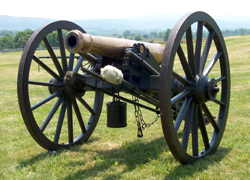
The M1841 6-pounder field gun was a bronze smoothbore muzzleloading cannon that was adopted by the United States Army in 1841 and used from the Mexican–American War to the American Civil War. It fired a 6.1 lb (2.8 kg) round shot up to a distance of 1,523 yd (1,393 m) at 5° elevation. It could also fire canister shot and spherical case shot (shrapnel). The cannon proved very effective when employed by light artillery units during the Mexican–American War. The cannon was used during the early years of the American Civil War, but it was soon outclassed by newer field guns such as the M1857 12-pounder Napoleon. In the U.S. Army, the 6-pounders were replaced as soon as more modern weapons became available and none were manufactured after 1862. However, the Confederate States Army continued to use the cannon for a longer period because the lesser industrial capacity of the South could not produce new guns as fast as the North.

The M1841 12-pounder field howitzer was a bronze smoothbore muzzle-loading artillery piece that was adopted by the United States Army in 1841 and employed during the Mexican–American War and the American Civil War. It fired a 8.9 lb (4.0 kg) shell up to a distance of 1,072 yd (980 m) at 5° elevation. It could also fire canister shot and spherical case shot. The howitzer proved effective when employed by light artillery units during the Mexican–American War. The howitzer was used throughout the American Civil War, but it was outclassed by the 12-pounder Napoleon which combined the functions of both field gun and howitzer. In the U.S. Army, the 12-pounder howitzers were replaced as soon as more modern weapons became available. Though none were manufactured after 1862, the weapon was not officially discarded by the U.S. Army until 1868. The Confederate States of America also manufactured and employed the howitzer during the American Civil War.

The 10-pounder Parrott rifle, Model 1861 was a muzzle-loading rifled cannon made of cast iron that was adopted by the United States Army in 1861 and often used in field artillery units during the American Civil War. Like other Parrott rifles, the gun breech was reinforced by a distinctive band made of wrought iron. The 10-pounder Parrott rifle was capable of firing shell, shrapnel shell, canister shot, or solid shot. Midway through the war, the Federal government discontinued the 2.9 in (74 mm) version in favor of a 3.0 in (76 mm) version. Despite the reinforcing band, the guns occasionally burst without warning, which endangered the gun crews. The Confederate States of America manufactured a number of successful copies of the gun.

The 20-pounder Parrott rifle, Model 1861 was a cast iron muzzle-loading rifled cannon that was adopted by the United States Army in 1861 and employed in field artillery units during the American Civil War. As with other Parrott rifles, the gun breech was reinforced by a distinctive wrought iron reinforcing band. The gun fired a 20 lb (9.1 kg) projectile to a distance of 1,900 yd (1,737 m) at an elevation of 5°. The 20-pounder Parrott rifle could fire shell, shrapnel shell, canister shot, and more rarely solid shot. In spite of the reinforcing band, the 20-pounder earned a dubious reputation for bursting without warning, killing or injuring gunners. The Confederate States of America also manufactured copies of the gun.
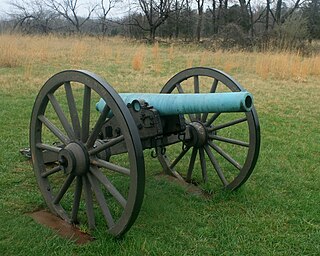
The 14-pounder James rifle or James rifled 6-pounder or 3.8-inch James rifle was a bronze muzzle-loading rifled cannon that was employed by the United States Army and the Confederate States Army during the American Civil War. It fired a 14 lb (6.4 kg) solid shot up to a distance of 1,530 yd (1,400 m) at 5° elevation. It could also fire canister shot and common shell. Shortly before the war broke out, the U.S. Army adopted a plan to convert M1841 6-pounder field guns from smoothbore to rifled artillery. Rifling the existing 6-pounders would both improve the gun's accuracy and increase the weight of the shell. There were two major types produced, both were bronze with a bore (caliber) of 3.8 in (97 mm) that would accommodate ammunition designed by Charles Tillinghast James. The first type looked exactly like an M1841 6-pounder field gun. The second type had a longer tube with a smooth exterior profile similar to a 3-inch Ordnance rifle. At first the rifles were quite accurate. However, it was discovered that the bronze rifling quickly wore out and accuracy declined. None of the rifles were manufactured after 1862, and many were withdrawn from service, though some artillery units employed the guns until the end of the war.

The M1841 24-pounder howitzer was a bronze smoothbore muzzle-loading artillery piece adopted by the United States Army in 1841 and employed from the Mexican–American War through the American Civil War. It fired a 18.4 lb (8.3 kg) shell to a distance of 1,322 yd (1,209 m) at 5° elevation. It could also fire canister shot and spherical case shot. The howitzer was designed to be employed in a mixed battery with 12-pounder field guns. By the time of the American Civil War, the 24-pounder howitzer was superseded by the 12-pounder Napoleon, which combined the functions of both field gun and howitzer. The 24-pounder howitzer's use as field artillery was limited during the conflict and production of the weapon in the North ended in 1863. The Confederate States of America manufactured a few 24-pounder howitzers and imported others from the Austrian Empire.
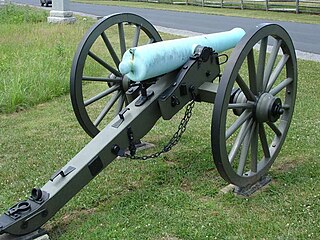
The M1857 12-pounder Napoleon or Light 12-pounder gun or 12-pounder gun-howitzer was a bronze smoothbore muzzle-loading artillery piece that was adopted by the United States Army in 1857 and extensively employed in the American Civil War. The gun was the American-manufactured version of the French canon obusier de 12 which combined the functions of both field gun and howitzer. The weapon proved to be simple to produce, reliable, and robust. It fired a 12.03 lb (5.5 kg) round shot a distance of 1,619 to 1,680 yd at 5° elevation. It could also fire canister shot, common shell, and spherical case shot. The 12-pounder Napoleon outclassed and soon replaced the M1841 6-pounder field gun and the M1841 12-pounder howitzer in the U.S. Army, while replacement of these older weapons was slower in the Confederate States Army. A total of 1,157 were produced for the U.S. Army, all but a few in the period 1861–1863. The Confederate States of America utilized captured U.S. 12-pounder Napoleons and also manufactured about 500 during the war. The weapon was named after Napoleon III of France, who helped develop the weapon.
One of them, which sends a 100 lb (45 kg) shell, was fired fifteen times, and another, which sends a 200 lb (91 kg) shell, was fired five times.